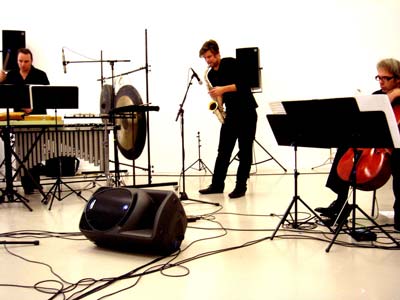COMPOSES
Ventriloquium
- duration:14'
- year:2006
- instrumentation:for amplified violoncello, electric guitar, percussion, two improvising musicians and live-electronics
- commissioned by:Festival van Vlaanderen (TRANSIT)
- Recording: Sub Rosa portrait cd "Fremdkörper"
- full score
Program Notes
The title, Ventriloquium, refers to the following quotation by Jacques Derrida, which served as a conceptual starting point for the composition:
It's not easy to improvise. It's the most difficult thing to do. Even when one improvises in front of a camera or a microphone one ventriloquizes or leaves another to speak in one's place the schemas and languages that are already there. There are already a great number of prescriptions that are prescribed in our memory and in our culture. All the names are already preprogrammed. It's already the names that inhibit our ability to ever really improvise. One can't say whatever one wants. One is obliged, more or less, to reproduce the stereotypical discourse. And so I believe in improvisation. And I fight for improvisation. But always with the belief that it's impossible. And there, where there is improvisation I am not able to see myself. I am blind to myself and it's what I will see, no I won't see it, it's for others to see. The one who is improvised here, no, I won't ever see him.(Jacques Derrida, Screenplay and Essays on the Film Derrida by Kirby Dick and Amy Ziering Kofman, Routledge, New York 2005)

The subject of investigation in this composition is –as in Derrida’s text- the relation between “improvisation” and “text”. Related and investigated questions are: what is the rôle of “culture” as collective and individual memory in this relation? How is the individual related to the collective and how does “technology” change this relation. Does the “individual” exist uberhaupt, or is he only what higher structures dictate him to be.
These questions are investigated by placing a trio performing mainly notated music against a purely improvising duo and by creating different types of contexts (“higher structures”), wherein the individual (i.e. the improvising musicians) is functioning according to the “rules” of the structures. In the first part, for example, the two improvising musicians, have to “integrate” as much as possible into the ensemble-texture. In the second part, this ensemble-texture starts to differentiate and splits into different directions, the improvisers start to exhibit “individual” behavior and are asked to “destabilize” the written-out structure.
At the end of this second part, the two improvisers continue alone, and establish a new group-paradigm, which grew out of the previous parts. At its turn, the trio (vc, gtr, perc) starts to destabilize this new structure in the next part, using pre-composed text-fragments, combined with free improvisation. Different kinds of “alliances” are created, and investigate how precomposed text/pre-established structures influence the “free” improvisations. In the fifth and final part, a new structure is being build up gradually, while “residuals” of the previous structures serve as a starting point for the “background-improvisations” of both the trio and the duo.
These improvisations are thinned out bit by bit, until a clearly new structure is being created in which the two improvisers should integrate again. It will be clear by now, that this composition is not at all a kind of “double concerto” for improvising duo with trio and live-electronics. All instruments are treated as equals, only the way of communication between the instruments differs (and changes during the piece), and it is exactly on this domain that the main “investigation” is being done. The way the composer creates structures and information, is being confronted with/enriched by the way this information is elaborated during the improvisations.
The concept of the “Ventriloquism” is, on another level, elaborated in the spatialisation of the compostion as well. Each instrument is amplified (strongly), and the amplified sound is being sent to a fixed speaker for every instrument, standing at the opposite side of the stage. The instrumentalists control the amount of amplification in these speakers through their volume pedal. In the beginning of the composition, the relation between instrument and speaker is 1/1. From section B onwards, the live-electronics start to “distort” this 1/1-image, with granular processes which are unleashed on the live sounds.
This composition, premiered by Champ d’Action and collectief reFLEXible on 27/10/2007 at “STUK” in Leuven during the Transit Festival, was commissioned by Festival van Vlaanderen.